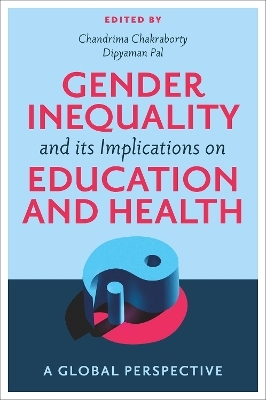
Gender Inequality and its Implications on Education and Health
Emerald Publishing Limited (Verlag)
978-1-83753-181-3 (ISBN)
Gender Inequality and its Implications on Education and Health explains the different implications of gender inequality and finds solutions to our most pressing issues. The authors of these collected studies show that though in various contexts around the globe, girls and women are discouraged and prevented from receiving quality education, proper health care, women empowerment and social justice, if this exclusion is eliminated it produces many additional socio-economic gains that benefit entire societies. Focusing largely on India to explore firstly the implications of gender inequality on education and health and then gender inequality and its implications to other SDGs, the chapters extend globally to analyse countries from Asia, Australia, Africa, and Europe.
Raising awareness among stakeholders and institutions to recognise the importance of gender inequality throughout the world and its various implications – especially on education and health – Gender Inequality and its Implications on Education and Health provides strategies to achieve gender equality.
Chandrima Chakraborty is Assistant Professor of Economics at Vidyasagar University, West Bengal, India. Her research interests include Econometrics, Empirical-studies-on-Gender/Education/Productivity/Efficiency/Environmental and Health economics. Dipyaman Pal is Assistant Professor of Economics at Bethune College, West Bengal, India. His research interests include Econometrics, Empirical-studies-on-Gender/Volatility/Productivity/Efficiency/Environmental and Health economics.
Section I. Implications of Gender Inequality on Education and Health
Chapter 1. Adverse Child Sex Ratio in India: The Role of Women’s Agency An Empirical Analysis; Antara Bhattacharyya and Sushil Kr. Haldar
Chapter 2. Do Government Expenditures on Education and Health Reduce Gender Inequality? The case of the Least Developed and Developing Countries; Gizem Kaya Aydin
Chapter 3. Is there any relationship between gender inequality and nutrition? Experience from India; Kavitha Kasala, Rudra Prosad Roy, and Abhishek Das
Chapter 4. Gender Discrimination in Education Expenditure in Public Primary School in Rural India among Religious Groups: An Oaxaca-Blinder Decomposition Analysis; Puja Biswas and Amit Kundu
Chapter 5. Can gender inequality in school enrolment hinder the efficiency of education sector?; Sangita Choudhury and Arpita Ghose
Chapter 6. Understanding Gender Through an Educational Construct; Manisha Subba
Chapter 7. Gender inequality in India intertwined between education and employment; Dyuti Chatterjee and Pallabi Banerjee
Chapter 8. A Critique of Gender Inequality: Study of Education and Health in North Bengal Region; Bishal Rai
Chapter 9. Gender Bias in Child Deprivation: A Study in the context of West Bengal, India; Satyanarayan Kumbhakar and Pinaki Das
Chapter 10. Is Dropout in Schools related to Gender and Birth Order?; Chayanika Mitra and Indrani Sengupta
Chapter 11. Investigating the role of air quality and the nexus between female health status and their labour force participation rate: Evidence from rural India; Kaushiki Banerjee and Arpita Ghose
Section II: Gender Inequality and its implications to Other SDGs
Chapter 12. Only Development or Gender Norm? Explaining Gender Inequality in Emerging Market Economies; Amrita Chatterjee
Chapter 13. Women Empowerment as A Key to Support Achievement of the Sustainable Development Goals and Global Sustainable Development; Begum Sertyesilisik
Chapter 14. Linkage Between Women Empowerment and Gender-Based Violence in India: Evidence from NFHS-5 Data; Susobhan Maiti, Tanushree Gupta, and Govind Singh Rajpal
Chapter 15. Public Social Expenditures and Outcomes in Nigeria: A Look Through Gender Lens; Nkechinyere Rose Uwajumogu, Ebele Stella Nwokoye, Kingsley Chike Okoli, and Mgbodichimma K. Okoro
Chapter 16. Equitable pathways for a Sustainable Future:The Case for Mainstreaming Gender across Sustainable Development Goals (SDGs); Ananya Chakraborty and Sreerupa Sengupta
Chapter 17. Sustainable Environment and Urbanization Policies to Enhance Gender Equality and Women Empowerment; Egemen Sertyesilisik
Chapter 18. Understanding Gender, Poverty and Social Justice: A New Look from the Perspectives of Indian Experience; Asim K. Karmakar, Sebak K. Jana, and Sovik Mukherjee
Chapter 19. Twitter imparting and reinforcing gendered based identities of the Aboriginal Australia women; Ali Saha
Chapter 20. The Impact of Pandemic on the Female Unorganized Sector Workers: A Study in Rural Backdrop of West Bengal; Srimoyee Datta and Tarak Nath Sahu
Chapter 21. A Gender Sustainable Development Index for Italian Regions; Marianna Bartiromo and Enrico Ivaldi
Chapter 22. Association between Crime Against Women and Income Inequality: A Study on Indian States; Debarati Nandigrami and Ramesh Chandra Das
Chapter 23. Gender Responsive Budgeting Approach to Combating Climate Change; Gamze Yıldız Şeren
| Erscheinungsdatum | 11.08.2023 |
|---|---|
| Verlagsort | Bingley |
| Sprache | englisch |
| Maße | 152 x 229 mm |
| Gewicht | 595 g |
| Themenwelt | Sozialwissenschaften ► Soziologie ► Gender Studies |
| Sozialwissenschaften ► Soziologie ► Makrosoziologie | |
| ISBN-10 | 1-83753-181-1 / 1837531811 |
| ISBN-13 | 978-1-83753-181-3 / 9781837531813 |
| Zustand | Neuware |
| Haben Sie eine Frage zum Produkt? |
aus dem Bereich


